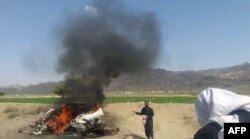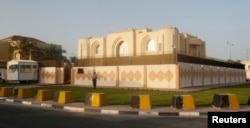The propaganda machine of the Afghan Taliban is in full swing.
The Taliban’s websites and social media accounts are buzzing with news of battlefield victories. Spectacular sweeps of territory and the capture and killing of Afghan security forces are now being streamed in sleek videos and drone footage.
But the hard-line movement finds itself mired in growing turmoil.
Factionalism is on the rise. Disagreements and rivalries among its founding members are playing out in the open. Internal disagreements are amplified by misgivings over covert relations with the Taliban’s main foreign backer, Pakistan.
Grievances over ideology, money, and mounting casualties in the Taliban’s biggest offensive since losing power in late 2001 are adding to dissent among rank-and-file Taliban.
The media machine, however, still claims that all is well.
“Any Taliban members who use media to resolve internal disagreements and [to advocate] reforms are bound to be rejected by the movement’s members,” read an editorial on the pro-Taliban Asia Today website.
The October 22 editorial attempted to downplay a bombshell letter by a former senior aide to the Taliban’s founding leader, Mullah Omar, published by RFE/RL’s Gandhara website last week.
In the letter, addressed to current Taliban leader Haibatullah Akhundzada, Sayed Mohammad Tayyeb Agha urged dramatic reforms to transform the militant organization into a legitimate political movement.
Agha said the Taliban’s leaders should return to Afghanistan and sever covert ties with Pakistan in order to make independent decisions. He asked Akhundzada to abandon all the Taliban’s claims of being a legitimate government, restrict the role of foreign jihadists, and show an interest in representing the wider Afghan society.
Agha, who served the Taliban for two decades, warned that unless the movement abandons violence against civilians and adopts a pragmatic political course, its future is bleak.
“If we don’t pay attention [to reform and change], the Taliban and our jihad will become loathsome,” Agha wrote to Akhundzada.
Seasoned observers say the tide is possibly changing within the fragmented movement.
“There is no doubt internal struggles within the Taliban have intensified [recently]. It began after Mullah Omar’s death was announced in July 2015,” said an Afghan government adviser with intimate knowledge of the secretive movement.
The source, who requested not to be identified, said the way the Taliban managed its leadership transition after accepting the news that Mullah Omar died in April 2013 has fomented internal divisions.
“His [Mullah Omar's] mysterious death and the way his predecessor was selected or imposed involved the visible highhandedness of the ISI (Inter-Services Intelligence),” he said, noting the influence wielded by the Pakistani secret service over the Afghan insurgents.
Since the demise of the Taliban regime in late 2001, Afghan and Western officials alike have accused Pakistan of sheltering fugitive Taliban leaders. In the 1990s, Islamabad officially recognized the Taliban regime and was considered its main sponsor.
Since the 1970s, the ISI has relied on militant Islamist organizations to influence or even shape Afghan politics.
Many Taliban members, however, have been unhappy over such influence.
Days after a secret Taliban gathering chose Mullah Akhtar Mohammad Mansur as Mullah Omar’s successor in July 2015, Agha resigned as head of the Taliban’s political office in Qatar. He said keeping Mullah Omar’s death a secret and the selection of Mansur as his successor in Pakistan were historic mistakes.
"The only way of salvation now is for the Taliban leaders to make sacrifices,” he urged in his August 2015 resignation letter. “They should move to somewhere inside Afghanistan and independently ponder the selection of their leader and other issues.”
Mansur Loyalists
In subsequent months, Mansur moved ruthlessly against factions that resisted an oath of allegiance to his leadership, opposed his selection, or sheltered Central Asian militants who had switched loyalties to the so-called Islamic State (IS).
Mansur, however, was killed in a U.S. drone strike in southwestern Pakistan in May -- a turn of events that forced yet another Taliban leadership transition.
He was succeeded by his theologian deputy, Haibatullah Akhundzada.
Mansur’s killing forced loyalists to cede control over the Taliban’s lucrative finances, making many suspicious of Islamabad’s intentions.
“Many of Mansur’s people believe that the U.S. was tipped off by the ISI [about their leader’s whereabouts],” the Afghan government adviser said. “Under Akhundzada, the ISI has become even more involved because he is seen as not being up to the task.”
In recent months, two Mansur confidants and key figures in raising and supervising Taliban funds, Mullah Ahmadullah Nanai and Mullah Samad Sani, were arrested in Quetta.
As the capital of restive southwestern Balochistan Province, the city has served as de facto Taliban headquarters since their leadership council decamped there in late 2001.
Pakistan, however, has maintained the arrests were part of its effort to “squeeze” the Taliban into joining talks with the Afghan government.
Haqqani Network
Mansur’s killing also elevated Sirajuddin Haqqani, the leader of the lethal Taliban arm known as the Haqqani network. He is now a key deputy of Akhundzada’s and a major figure in the movement’s military efforts.
In 2011, Admiral Mike Mullen, then the chairman of U.S. Joint Chief of Staff, told a U.S. Senate panel that the “Haqqani network acts as a veritable arm of Pakistan’s Inter-Services Intelligence agency.”
In recent years, the Haqqani network has been blamed for high-profile attacks in the Afghan capital with high numbers of civilian casualties that grab international headlines.
“The elevation of the Haqqanis as the mainstream Taliban leadership has made a lot of Taliban leaders resentful of the ISI and question the legitimacy of their war,” the Afghan adviser said.
Several Afghan, Pakistani, and Western sources noted that the rise of the Haqqanis has led to simmering regional divisions among the Taliban.
A seasoned Taliban watcher in Kabul said the Kandahari core of Taliban leaders sees the Haqqanis as Pakistan’s puppet.
Since the emergence of the Taliban in the southern Afghan province of Kandahar in 1994, most of its leaders -- and crucially those responsible for crafting its public image -- came from Kandahar and the surrounding provinces.
Their dominance of the hard-line movement is now challenged by the Haqqanis, who come from the southeastern Afghan provinces collectively called Loya Paktia. Resentful Taliban feel the Haqqanis consider other members second fiddle to their push for a military victory.
In addition to their internal squabbles, the Taliban are now suffering an unprecedented number of battlefield casualties as they try to overrun and hold territory in the Afghan countryside.
Their reliance on conventional combat has exposed them to NATO and Afghan air strikes and raids by Afghan special forces.
Observers say that while it is difficult to perceive the fragmentation between the Taliban’s Pakistan-based political leaders and battlefield commanders, there are increasing signs of disgruntled radicals launching independent attacks or even switching allegiance to IS.
Peace Process
The Taliban’s problems have also been mounting on the political front since the hard-line Hezb-e Islami or Islamic Party concluded a peace agreement with Kabul on September 29.
The Taliban have long been divided over reaching a political settlement with the government. As an organization constantly engaged in combat for most of its two-decade history, the Taliban faces several dilemmas in approaching peace talks.
One of its main challenges is to act independently. For years, it refused to hold direct talks with Kabul, calling it a “puppet” of the United States. For its part, Kabul emphasized reaching an understanding with Pakistan, saying the Taliban were mere proxies of Islamabad.
The two sides now appear to have softened such positions. Reports say Afghan intelligence chief Masoom Stanekzai met Mullah Omar’s brother Mullah Abdul Manan Akhund in Qatar within the past two months.
Both Kabul and the Taliban appear to be keen on beginning a new peace process among themselves, and without Pakistan’s involvement. In a sign that the Taliban are serious about pursuing peace, Mullah Omar’s son Mohammad Yaqoob is being tipped as the future head of the Taliban office in Qatar. Some sources say that Stanikzai also met him, in an effort to pave the way for a dialogue between the two sides.
Pakistan, however, is once again jostling for center stage in the Afghan peace process. It hosted the first round of direct peace talks between Kabul and the Taliban in 2015.
Reports suggest three senior Taliban members met with Pakistani officials this week to “brief” them on recent talks with Afghanistan.
Taliban sympathizers, however, see this as an effort to guard against Islamabad’s manipulation.
Nazar Muhammad Mutameen, a Kabul-based former Taliban official who often provides insight into insurgent positions, told VOA that Pakistan has always benefited from the war in Afghanistan and so the Taliban want to stop their new initiative from being sabotaged.
“It is a mistake to trust Pakistan or our other neighbors with the peace process, but there are many pressures and compulsions,” he said.
fg/








